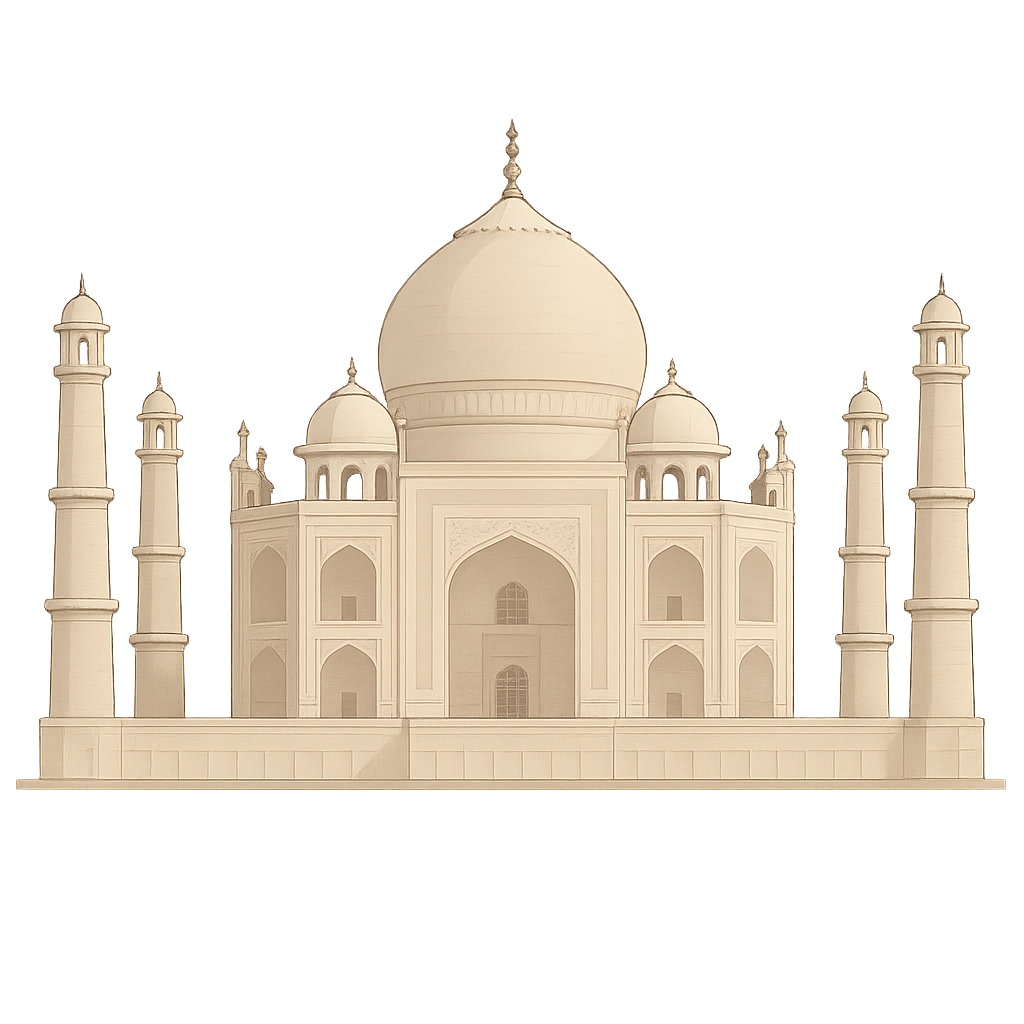The Teardrop on the Cheek of Time
My skin of white marble glows with the sun’s journey across the sky. At dawn, I blush a soft pink, as if waking from a long dream. By noon, I am a brilliant, dazzling white that makes you squint against the Indian sun. And when night falls, I shimmer with a gentle, golden light under the moon’s watchful eye. If you were to touch my walls, you would feel their cool, smooth surface, polished by centuries of wind and rain. Before me lies a long, still pool of water, and in it, you can see me perfectly, a flawless reflection staring back. I am more than just stone and mortar. I am a promise made from a place of deep love, a poem written in marble, a single, perfect teardrop on the cheek of time. I stand proudly in the city of Agra, along the banks of the Yamuna River. I am the Taj Mahal.
My story begins not with a blueprint or a king’s command for power, but with a broken heart. I was built because of the great love between the powerful Mughal Emperor, Shah Jahan, and his cherished wife, Empress Mumtaz Mahal. They ruled together in the 17th century, and their bond was legendary. She was his trusted companion and advisor, and he loved her more than anything in his vast empire. But in the year 1631, a great sadness fell upon the land. While giving birth to their fourteenth child, the Empress Mumtaz Mahal passed away. Shah Jahan was overcome with a grief so profound that the whole court mourned with him for two years. Before she died, he made a solemn promise to her. He vowed to build a mausoleum, a tomb, so magnificent and beautiful that the entire world would forever remember the story of their love. I am the fulfillment of that promise. Every arch, every dome, and every jewel inlaid in my walls is a testament to his devotion.
To keep such a grand promise required a monumental effort. My construction began in 1631, the very year the empress died, and it would take 22 years to complete me. The emperor summoned the most skilled artisans from all corners of his empire and even from Central Asia. More than 20,000 workers—masons, stonecutters, carvers, and artists—poured their talent and energy into my creation. The chief architect, a man of incredible vision named Ustad Ahmad Lahori, guided this massive undertaking. My foundation is made of sturdy brick, but my soul is the gleaming white marble brought all the way from Makrana, hundreds of kilometers away. Over 1,000 elephants were used to transport these heavy blocks and other precious materials. My white skin was then adorned with intricate designs made from 28 types of precious and semi-precious stones, like deep blue lapis lazuli from Afghanistan, rich green jade from China, bright turquoise from Tibet, and fiery carnelian from Arabia. Finally, in 1653, I was complete, a dream of love made real.
My design is a masterpiece of balance and meaning. If you look at me, you will see perfect symmetry; what appears on my left side is mirrored exactly on my right. My enormous central dome, which seems to float in the air, is surrounded by four smaller domes. At each of the four corners of my platform stand tall, slender towers called minarets. They were ingeniously designed to lean slightly outward. This was a clever safety measure, so that in the event of an earthquake, they would fall away from my main structure, protecting the tomb of Mumtaz Mahal within. My walls are not plain. They are covered in delicate carvings of flowers and vines and inlaid with beautiful calligraphy. These are not just any words, but verses from the Quran, written in black marble, that speak of paradise. I sit within a vast garden called a Charbagh, which is divided into four equal parts by channels of water. This garden was designed to be a vision of heaven on Earth, a peaceful, perfect place for the empress to rest for eternity.
My story is one of love, but also of sorrow. After I was completed, Shah Jahan’s own son overthrew him and imprisoned him in the nearby Agra Fort. For the last years of his life, from 1658 until his death in 1666, the old emperor could only gaze at me from a distance, a beautiful monument to the love he had lost. When he died, he was laid to rest beside his beloved Mumtaz Mahal, and so our story was complete. Today, I am a UNESCO World Heritage site and a symbol of India recognized all over the globe. Millions of visitors travel here each year to walk through my gardens and stand in my shadow. They come from different countries and speak different languages, but they all feel the same sense of wonder. I am more than a building. I am a story in stone, a whisper of love that has echoed through time, reminding everyone that from great feeling can come great beauty, connecting us all.
Reading Comprehension Questions
Click to see answer
